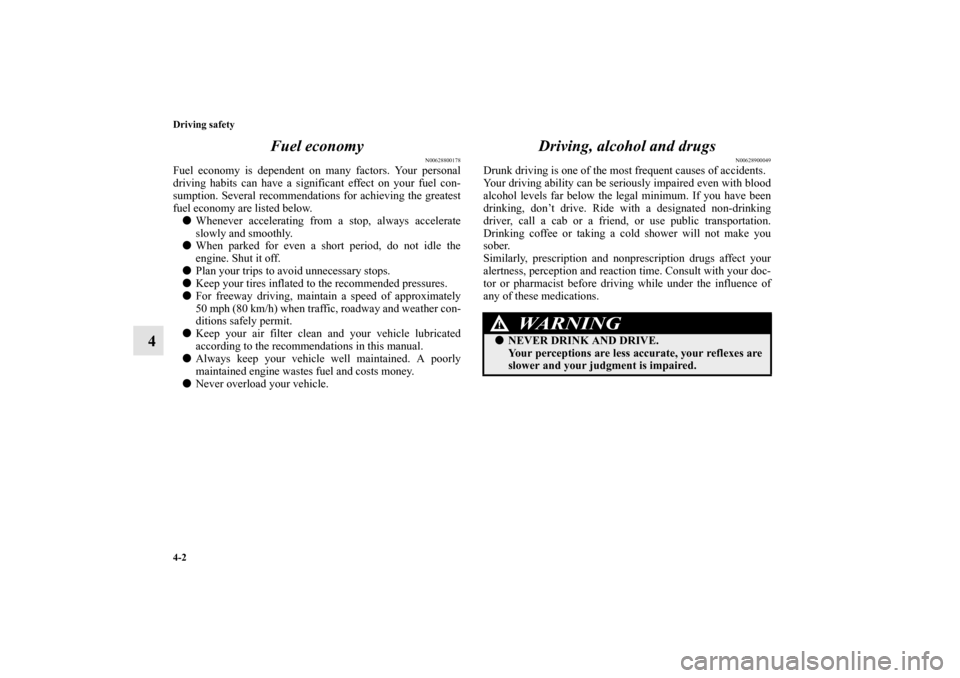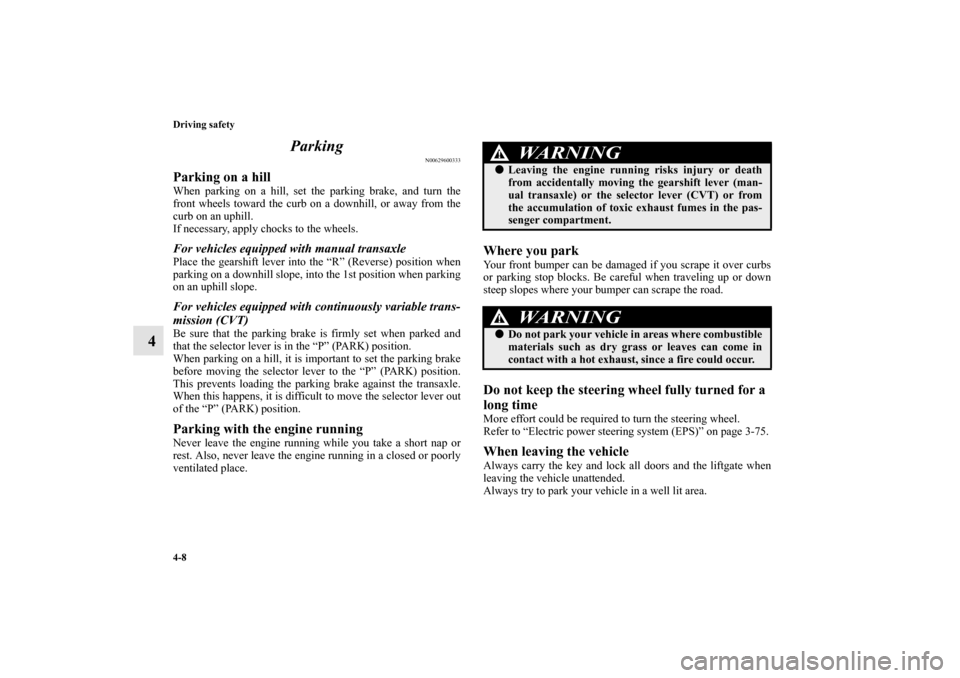Page 260 of 460

4-2 Driving safety
4Fuel economy
N00628800178
Fuel economy is dependent on many factors. Your personal
driving habits can have a significant effect on your fuel con-
sumption. Several recommendations for achieving the greatest
fuel economy are listed below.
�Whenever accelerating from a stop, always accelerate
slowly and smoothly.
�When parked for even a short period, do not idle the
engine. Shut it off.
�Plan your trips to avoid unnecessary stops.
�Keep your tires inflated to the recommended pressures.
�For freeway driving, maintain a speed of approximately
50 mph (80 km/h) when traffic, roadway and weather con-
ditions safely permit.
�Keep your air filter clean and your vehicle lubricated
according to the recommendations in this manual.
�Always keep your vehicle well maintained. A poorly
maintained engine wastes fuel and costs money.
�Never overload your vehicle.
Driving, alcohol and drugs
N00628900049
Drunk driving is one of the most frequent causes of accidents.
Your driving ability can be seriously impaired even with blood
alcohol levels far below the legal minimum. If you have been
drinking, don’t drive. Ride with a designated non-drinking
driver, call a cab or a friend, or use public transportation.
Drinking coffee or taking a cold shower will not make you
sober.
Similarly, prescription and nonprescription drugs affect your
alertness, perception and reaction time. Consult with your doc-
tor or pharmacist before driving while under the influence of
any of these medications.
WA R N I N G
!�NEVER DRINK AND DRIVE.
Your perceptions are less accurate, your reflexes are
slower and your judgment is impaired.
BK0162600US.book 2 ページ 2013年3月22日 金曜日 午後2時41分
Page 262 of 460

4-4 Driving safety
4
WA R N I N G
!�If a floor mat is the wrong size or is not properly
installed, it can interfere with the operation of the
pedals. Interference with the pedals can cause unin-
tended acceleration and/or increased stopping dis-
tances resulting in a crash and injury. Always make
sure the floor mat does not interfere with the accel-
erator or brake pedal.�Always use the retaining clip on the driver’s floor-
board to secure the floor mat.�Always install the mat with the correct side facing
down.�Never install a second mat over or under an existing
floor mat.�Do not use a floor mat designed for another model
vehicle even if it is a Mitsubishi genuine floor mat.
WA R N I N G
!�Before driving, be sure to check the following:
• Periodically check that the floor mat is properly
secured with the retaining clips.
If you remove the floor mat while cleaning the
inside of your vehicle or for any other reason,
always check the condition of the floor mat after it
has been reinstalled.
• While the vehicle is stopped with the engine off,
check that the floor mat is not interfering with the
pedals by depressing the pedals fully.
BK0162600US.book 4 ページ 2013年3月22日 金曜日 午後2時41分
Page 264 of 460

4-6 Driving safety
4Safe driving techniques
N00629200137
Even this vehicle’s safety equipment, and your safest driving,
cannot guarantee that you can avoid an accident or injury.
However, if you give extra attention to the following areas, you
can better protect yourself and your passengers:
�Drive defensively. Be aware of traffic, road and weather
conditions. Leave plenty of stopping distance between
your vehicle and the vehicle ahead.
�Before changing lanes, check your mirrors, your blind
spots, and use your turn-signal light.
�While driving, watch the behavior of other drivers, bicy-
clists, and pedestrians.
�Always obey applicable laws and regulations. Be a polite
and alert driver. Always leave room for unexpected
events, such as sudden braking.
�If you plan to drive in another country, obey their vehicle
registration laws and make sure you will be able to get the
right fuel.
Driving during cold weather
N00629400474
�Check the battery. At the same time, check the terminals
and wiring. During extremely cold weather, the battery
will not be as strong. Also, the battery power level may
drop because more power is used for cold starting and
driving.
Before driving the vehicle, check to see if the engine runs
at the proper speed and if the headlights are as bright as
normally. Charge or replace the battery if necessary. Dur-
ing extreme cold weather, it is possible that a very low
battery could freeze.
�Warm the engine sufficiently. After starting the engine,
allow a short warm-up time to distribute oil to all cylin-
ders. Then drive your vehicle slowly.
�Stay at low speeds at first so that the manual transaxle oil
or the automatic transaxle fluid has time to spread to all
the lubrication points.
�Manual transaxle can be harder to shift in cold weather
conditions. This is normal and shifting will get easier as
the transaxle warms up.
WA R N I N G
!�The battery gives off explosive hydrogen gas. Any
spark or flame can cause the battery to explode,
which could cause serious injury or death.
Always wear protective clothes and a face mask
when working with your battery, or let a skilled
mechanic do it.
BK0162600US.book 6 ページ 2013年3月22日 金曜日 午後2時41分
Page 265 of 460

Driving safety
4-7
4
�Check the engine antifreeze.
If there is not enough coolant because of a leak or from
engine overheating, add Mitsubishi Motors Genuine
Super Long Life Coolant Premium or equivalent.
Please read this section in conjunction with the “Engine
coolant” on page 7-11.
Braking
N00629500521
All parts of the brake system are critical to safety. Have the
vehicle serviced by an authorized Mitsubishi Motors dealer or
a repair facility of your choice at regular intervals according to
the “WARRANTY AND MAINTENANCE MANUAL”.When brakes are wetCheck the brake system while driving at a low speed immedi-
ately after starting, especially when the brakes are wet, to con-
firm they work normally.
A film of water can be formed on the brake discs or brake
drums, and prevent normal braking after driving in heavy rain
or through large puddles, or after the vehicle is washed. If this
occurs, dry the brakes out by driving slowly while lightly
depressing the brake pedal.When driving in cold weatherOn snowy roads, ice can form on the braking system, making
the brakes less effective. While driving in such conditions, pay
close attention to surrounding vehicles and to the condition of
the road surface. From time to time, lightly depress the brake
pedal and check how effective the brakes are.When driving downhillIt is important to take advantage of the engine braking by
downshifting while driving on steep downhill roads in order to
prevent the brakes from overheating.
WA R N I N G
!�Never open the radiator cap when the radiator is
hot. You could be seriously burned.
BK0162600US.book 7 ページ 2013年3月22日 金曜日 午後2時41分
Page 266 of 460

4-8 Driving safety
4Parking
N00629600333
Parking on a hillWhen parking on a hill, set the parking brake, and turn the
front wheels toward the curb on a downhill, or away from the
curb on an uphill.
If necessary, apply chocks to the wheels.For vehicles equipped with manual transaxlePlace the gearshift lever into the “R” (Reverse) position when
parking on a downhill slope, into the 1st position when parking
on an uphill slope.For vehicles equipped with continuously variable trans-
mission (CVT)Be sure that the parking brake is firmly set when parked and
that the selector lever is in the “P” (PARK) position.
When parking on a hill, it is important to set the parking brake
before moving the selector lever to the “P” (PARK) position.
This prevents loading the parking brake against the transaxle.
When this happens, it is difficult to move the selector lever out
of the “P” (PARK) position.Parking with the engine runningNever leave the engine running while you take a short nap or
rest. Also, never leave the engine running in a closed or poorly
ventilated place.
Where you parkYour front bumper can be damaged if you scrape it over curbs
or parking stop blocks. Be careful when traveling up or down
steep slopes where your bumper can scrape the road.Do not keep the steering wheel fully turned for a
long timeMore effort could be required to turn the steering wheel.
Refer to “Electric power steering system (EPS)” on page 3-75.When leaving the vehicleAlways carry the key and lock all doors and the liftgate when
leaving the vehicle unattended.
Always try to park your vehicle in a well lit area.
WA R N I N G
!�Leaving the engine running risks injury or death
from accidentally moving the gearshift lever (man-
ual transaxle) or the selector lever (CVT) or from
the accumulation of toxic exhaust fumes in the pas-
senger compartment.
WA R N I N G
!�Do not park your vehicle in areas where combustible
materials such as dry grass or leaves can come in
contact with a hot exhaust, since a fire could occur.
BK0162600US.book 8 ページ 2013年3月22日 金曜日 午後2時41分
Page 278 of 460
5-6 Comfort controls
5Heater without air conditioning function
(if
so equipped)
N00737700031
The heater can only be used while the engine is running.Control panel
N00737800032
Blower speed selection dial
N00737900033
When the ignition switch is in the “ON” position, select the
blower speed by turning the blower speed selection dial.
Turning the dial clockwise will increase the blower speed;
turning the dial counterclockwise will decrease it. When the
dial is set to the “OFF” position, all fan-driven airflow will
stop.
1- Temperature control lever
2- Air selection lever
3- Mode selection dial
4- Electric rear window defogger switch → P. 3 - 1 2 5
5- Blower speed selection dial
BK0162600US.book 6 ページ 2013年3月22日 金曜日 午後2時41分
Page 283 of 460
Comfort controls
5-11
5 Manual air conditioning
(if so equipped)
N00730300344
The air conditioning can only be used while the engine is run-
ning.Control panel
N00730500304
Blower speed selection dial
N00736500205
When the ignition switch or the operation mode is in ON,
select the blower speed by turning the blower speed selection
dial.
Turning the dial clockwise will increase the blower speed;
turning the dial counterclockwise will decrease it. When the
dial is set to the “OFF” position, all fan-driven airflow will
stop.
1- Temperature control lever
2- Air selection lever
3- Mode selection dial
4- Electric rear window defogger switch→ P.3-125
5- Air conditioning switch
6- Blower speed selection dial
BK0162600US.book 11 ページ 2013年3月22日 金曜日 午後2時41分
Page 284 of 460
5-12 Comfort controls
5
Temperature control lever
N00736600248
The temperature control lever is used to select the desired air
temperature.NOTE�While the engine coolant temperature is low, the tempera-
ture of the air from the heater will be cool/cold until the
engine warms up, even if you have selected warm air with
the lever.
Mode selection dial
N00736700223
To change the amount of air flowing from the vents, turn the
mode selection dial. Refer to “Changing the mode selection”
on page 5-3.
1- Cooler
2- Warmer
BK0162600US.book 12 ページ 2013年3月22日 金曜日 午後2時41分